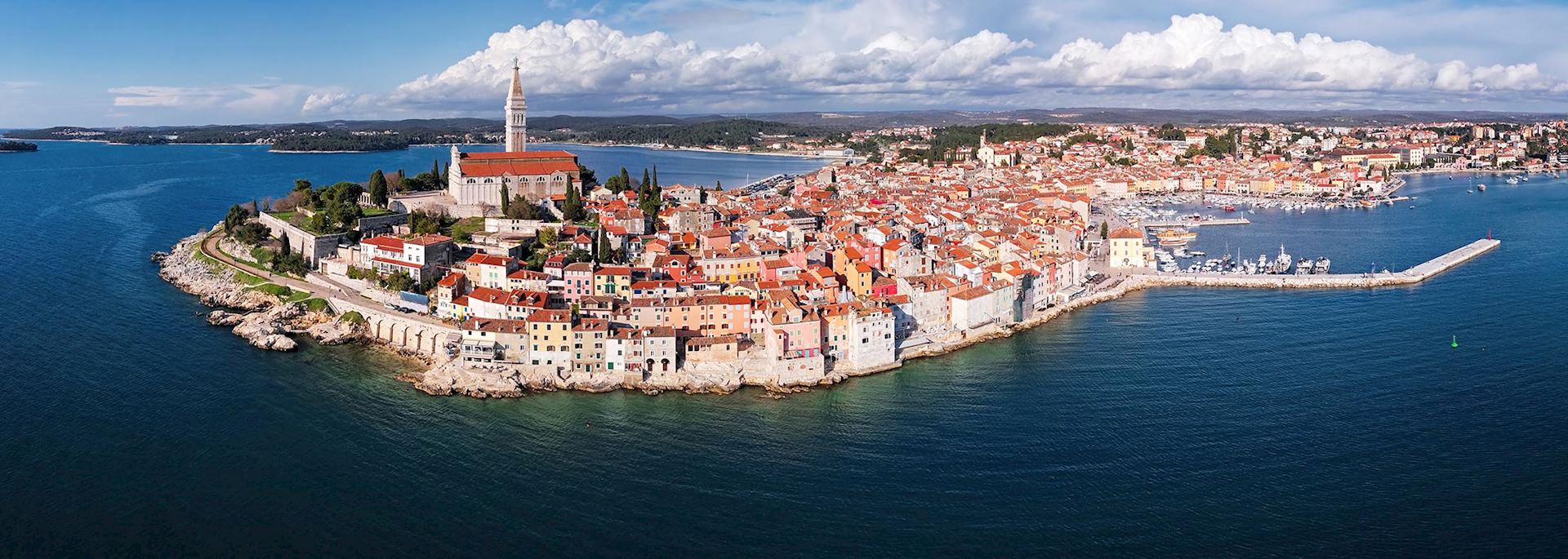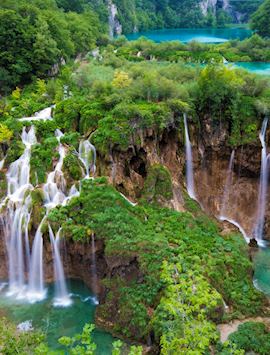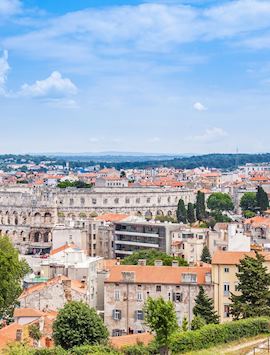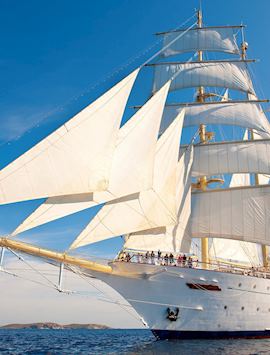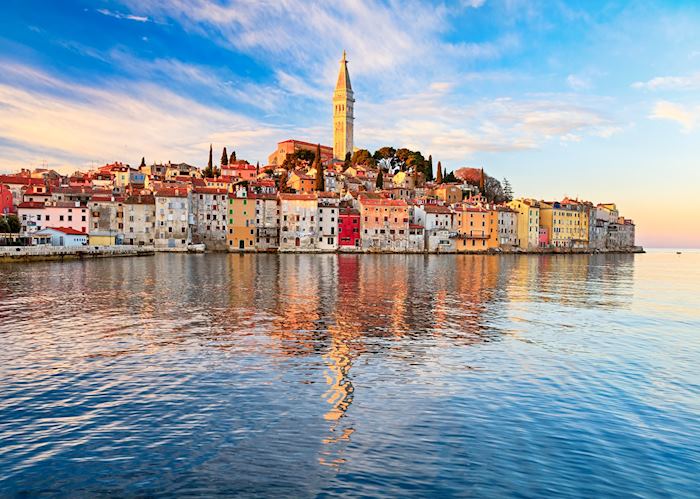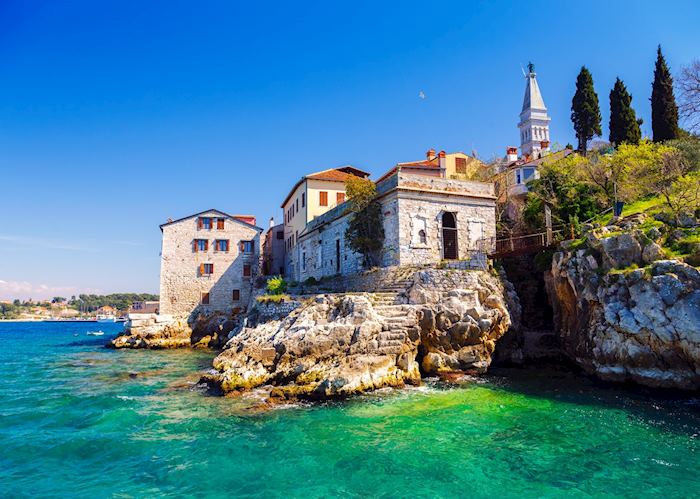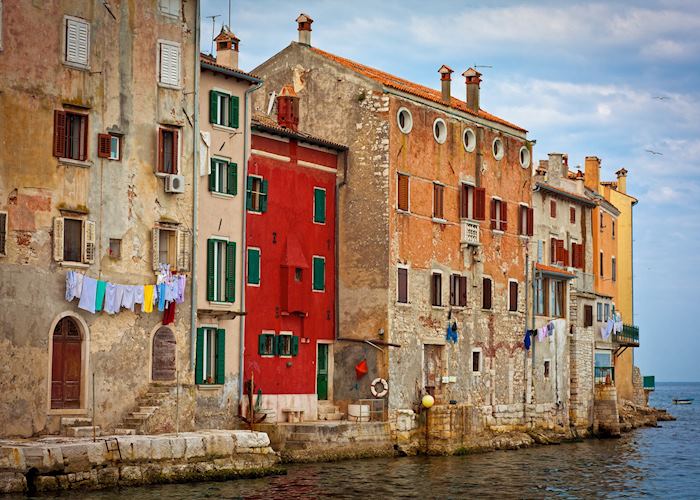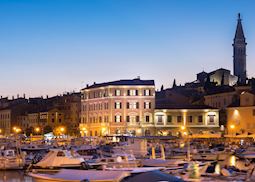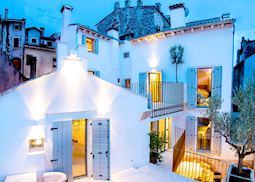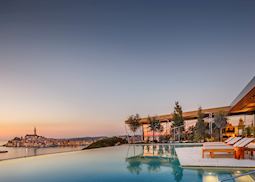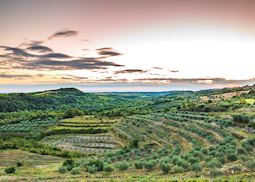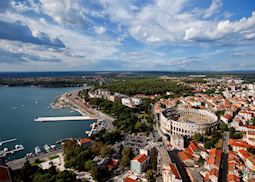Jump to:
Looking like a little piece of Venice on Croatia’s Istrian coast, Rovinj is both a historic town once under Venetian rule and an Italian-inspired beach resort. You can easily walk its distance in an hour, but it and the surrounding coast hold enough to occupy you for at least a couple of days. The church of Saint Euphemia, with its campanile and sunset-facing terrace, marks the town’s highest point, and the stony Adriatic-lapped beaches its lowest. The town is buoyed by a glut of restaurants, cafés and gelaterias, out of which you’d be unlucky to pick a dud.
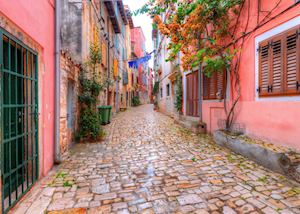 Irregular, age-pitted marble cobbles cover the alleyways of Rovinj’s old town. Whichever entry point you take, you’ll walk up steep lanes that inevitably lead you to the Baroque church of Saint Euphemia. The bell tower could have been lifted straight out of Venice, its design taking inspiration from the campanile in St Mark’s Square. Saint Euphemia’s sarcophagus resides inside, and her weathered-green statue tops the tower.
Irregular, age-pitted marble cobbles cover the alleyways of Rovinj’s old town. Whichever entry point you take, you’ll walk up steep lanes that inevitably lead you to the Baroque church of Saint Euphemia. The bell tower could have been lifted straight out of Venice, its design taking inspiration from the campanile in St Mark’s Square. Saint Euphemia’s sarcophagus resides inside, and her weathered-green statue tops the tower.
For a nominal admission price, you’re able to climb to the top of the tower. The route leads you up and then back down an open series of wooden stairs, which follow the square footprint of the tower to the belfry with little care to conceal the drop. Stepping out onto the open-air belfry, you can gaze out through archways in each direction. Looking down from every side, you have the red roofs of the town below, followed by wooded countryside (Rovinj is replete in green space) with the Mediterranean and a smattering of outlying islands beyond.
The façade of the church leads down via a wide flank of steps to a square-cum-viewing platform over the sea. Residents and visitors congregate here toward sundown to follow the ever-more-fiery descent of the sun below the horizon line.
Just below the church, tracing your way back down the old town, is Grisia. A steep street even by Rovinj’s standards, it’s known for its craft shops. You can pick up locally made produce, handicrafts and artworks, from silvery ragu pottery fish to gifts made from Istrian-grown lavender.
At the very foot of the old town, before it spills out into the newer part of Rovinj, you’ll happen upon a little plaza. A tight-knit triangle set out with intermingling tables and chairs from the restaurants and bars lining it, the square siphons you out into the new town through the Balbi Gate.
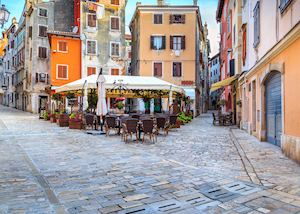 Another remnant from Rovinj’s Venetian rule, the arch is topped by a stone-carved lion of Saint Mark. Normally the shy and retiring type, here his genitalia are (unusually) very much on display.
Another remnant from Rovinj’s Venetian rule, the arch is topped by a stone-carved lion of Saint Mark. Normally the shy and retiring type, here his genitalia are (unusually) very much on display.
If you follow the path past the boats and yachts in Rovinj’s waterfront, in about five minutes you’ll come to the gates of Punta Corrente. The landscaping vision of 19th-century entrepreneur Georg Hütterott, this forested cape is the town’s natural escape where you can join locals in cycling and walking trails between groves of cypresses and pines.
The designated nature park also gives you direct entry into the clear waters of the Adriatic from a succession of coves and flat rocks that curve around the park’s perimeter. Bathing points closer to town are busier, but if you continue walking or cycling along the path, you’ll soon come to quieter spots.
Back in Rovinj, the House of Batana in the old town regales the town’s links to the sea through its celebration of the flat-bottomed fishing vessel, the batana. The museum is based in a 17th-century house typical of the time where generations of fishing families have lived over the decades.
Along with visiting the museum’s exhibition space, you can eat at its traditional wine tavern, Spacio Matika. At one time, every street in Rovinj was incomplete without a spacio, where fishermen congregated to eat, drink and make song. An evening at Spacio Matika evokes this bygone atmosphere, as you’re served regional produce including seafood fresh from the boat.
On the edge of the old town, the Rovinj Heritage Museum introduces you to the locality, its inhabitants and its way of life. The building itself, with its candy-pink façade, is a former palace in the Baroque style and sits in the main square close to the water. The museum serves as both an art gallery and exhibition space, leading you through collections stretching from prehistoric archaeological remains found in the area to contemporary art by Croatian and international artists.
Best time to visit Rovinj
Istria’s Mediterranean climate makes Rovinj a pleasant place to visit at any time of year. Winters are mild, and summers bring clear, warm days blessed with sunshine. We advise against visiting in the heat of high summer, during July and August, when the town sees its most visitors under sometimes sweltering temperatures.
who's been there
-
617-223-4521617-223-4747
- Make an inquiry
Suggested itineraries featuring Rovinj
Our itineraries will give you suggestions for what is possible when you travel in Rovinj, and they showcase routes we know work particularly well. Treat them as inspiration, because your trip will be created uniquely by one of our specialists.
Places near Rovinj
- Istria 16 miles away
- Pula 18 miles away
- Plitviče Lakes 98 miles away
- Zadar 103 miles away
- Zagreb 125 miles away
- Šibenik 146 miles away
- Trogir 169 miles away
- Šolta 176 miles away
- Split 177 miles away
- Brač 192 miles away
- Dalmatian Coast 193 miles away
- Hvar 200 miles away
- Korčula 221 miles away
- Dubrovnik 279 miles away
Photos of Rovinj
Accommodation choices for Rovinj
We've selected a range of accommodation options for when you visit Rovinj. Our choices usually come recommended for their character, facilities and service or location. Our specialists always aim to suggest properties that match your preferences.
-
![Hotel Adriatic, Rovinj]()
Hotel Adriatic
Rovinj -
![Spirito Santo Palazzo Storico, Rovinj]()
-
![Grand Park Hotel, Rovinj]()
Grand Park Hotel Rovinj
Rovinj
Ideas for experiencing Rovinj
Our specialists seek out authentic ways to get to know the places that could feature in your trip. These activities reflect some of the experiences they've most enjoyed while visiting Rovinj, and which use the best local guides.
-
Gourmet Istria (Grožnjan, wineries and olive oil) ![Istrian vineyards]()
Gourmet Istria (Grožnjan, wineries and olive oil)
Gourmet Istria (Grožnjan, wineries and olive oil)
Istria’s rolling hills are home to a variety of award-winning wineries and olive farms — a visit offers an opportunity to learn about oil and wine production, sample local fare and explore a historic town renowned for its artists and musicians.
View details -
Walking tour of Rovinj & Pula ![Pula waterfront, Istria]()
Walking tour of Rovinj & Pula
Walking tour of Rovinj & Pula
Wander down cobbled streets and through secluded squares on this full-day walking tour of Rovinj and Pula, two of Istria’s handsome coastal towns. Learn about their history and architecture, visit a Roman arena and enjoy sweeping views of the Adriatic.
View details
